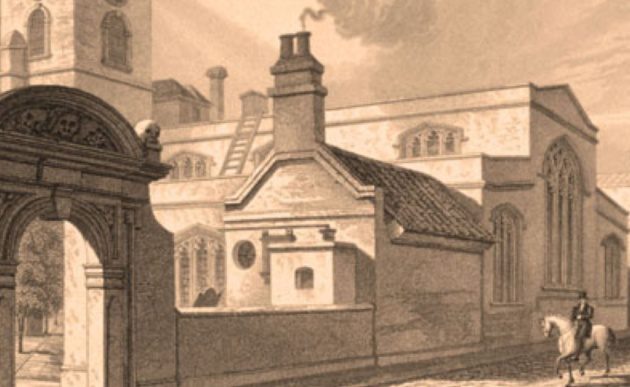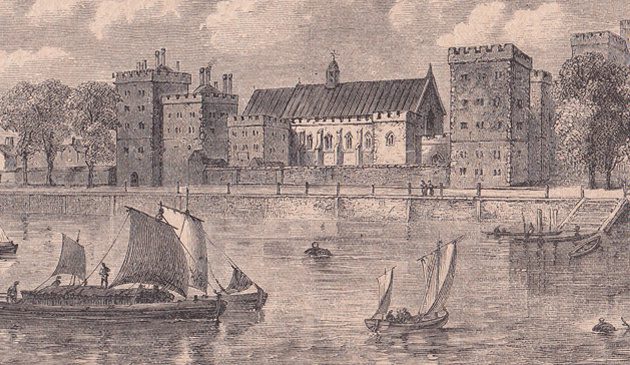All Hallows by-the-Tower church

The old church of St. Hallows-by-the-Tower as it was in the past, prior its devastation during the Second World War. The 17th century tower survived and a steeple was added to it during the early 1950s.
The church of All Hallows by-the-Tower stands beside the Tower of London. Dating back to the introduction of Christianity into Britain during the Saxon period it can claim to be the oldest church in the City and one of the earliest in London. It was heavily bombed during the Second World War but rebuilt and reopened in the 1950s.
All Hallows by-the-Tower was founded by Erkenwald, Bishop of London, in 675AD as a chapel of Barking Abbey to the east of London, and for centuries it was referred to as All Hallows Barking. Erkenwald’s sister Ethelburga was Abbess at the Benedictine female order of Barking Abbey. It remained an appanage of the abbey until 1539 when Barking Abbey was dissolved by Henry VIII. There have been eight London churches named All Hallows. ‘All Hallows’ is an ancient form of ‘All Saints’, the feast day of which honours all Christian martyrs, preceded the previous day by Halloween.
All Hallows, standing beside the Tower of London, and hence its modern name, is three hundred years older than the oldest parts of its neighbour. The first church structure would have been wooden and later replaced by one of stone, and it still contains brickwork and other remains from the Saxon period. In the undercroft can also be found a section of much older terracotta flooring from a Roman house that stood on the same site in the second century AD.
The old medieval church contained what Walter Thornbury, who visited it in the late 19th century, described as “massive pillars and sharp-pointed arches”. The altar of the undercroft chapel is built from bricks brought back by the Knights Templar from Richard I’s Castle Athlit in Palestine and contains the Templar cross carved into it. In 1311 several Knights Templar, who were accused of heresy, were held in the undercroft prior to their trial in the church. A Lady Chapel was erected as a royal chantry-chapel by Edward IV in the 15th century.
In his Survey of London, written in 1598, John Stowe describes All Hallows as:
the fair parish church called Allhallows Barking, which standeth in a large, but sometime larger, cemetery or churchyard; on the north side whereof was sometime built a fair chapel, founded by King Richard I.: some have written that his heart was buried there under the high altar.
Stow lists numerous notable people, including knights, merchants, and members of the royal household who had their monuments within the church. The mention of Richard I’s heart buried there is an erroneous legend.
Several of those executed for treason on Tower Hill were buried at All Hallows. When Cardinal John Fisher, Bishop of Rochester was beheaded by order of Henry VIII in 1535 for refusing to accept him as head of the Church in England his body was thrown naked into a rough grave in the churchyard. A fortnight later the body was moved to be beside that of Sir Thomas More at St. Peter ad Vincula within the Tower of London. His severed head was stuck on a pike on London Bridge and then later thrown in the Thames. The highly unpopular and controversial Archbishop of Canterbury William Laud was initially buried at All Hallows following his execution by order of Charles I in 1645. After the Restoration of 1660 his body was removed to the chapel of St. John’s College, Oxford. Laud’s nephew, Dr. Edward Layfield, had been vicar of All Hallows since 1634. He was dragged from the church in 1643 by Parliamentary soldiers and imprisoned for introducing various ‘popish’ innovations. He was returned to All Hallows following the Restoration of the Monarchy in 1660.
An enormous explosion took place in the adjacent Tower Street, against the wall of the churchyard, in January 1649 when seven barrels of gunpowder in the house of a ships’ chandler caught alight. Two doors along from the chandler’s house was the busy Rose tavern where the parish dinner was taking place. Rescuers dug for several days, finding bodies whole or in parts. It was recorded that a baby girl was found alive in a cradle on the roof of the church but never claimed by a parent. Sixty-seven people were killed, many left badly injured, and there was great devastation to the buildings surrounding All Hallows. Much damage was done to the church itself, with all the windows blown out. The tower was damaged enough that the decision was taken to replace it in red brick during 1659, with a clock and the figure of an angel sounding a trumpet. The building of churches during the Cromwellian era was unusual and the tower of All Hallows is the only part of a church in the City of London from that period.


